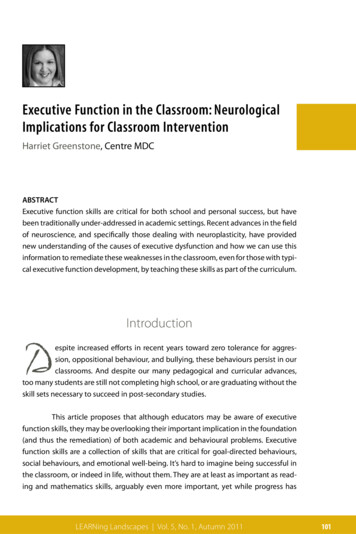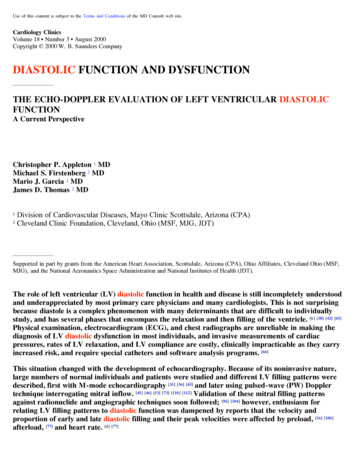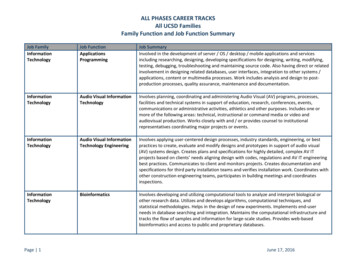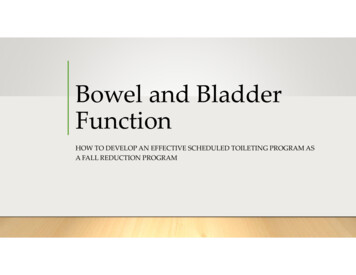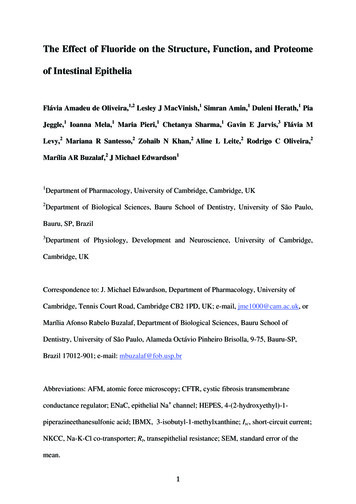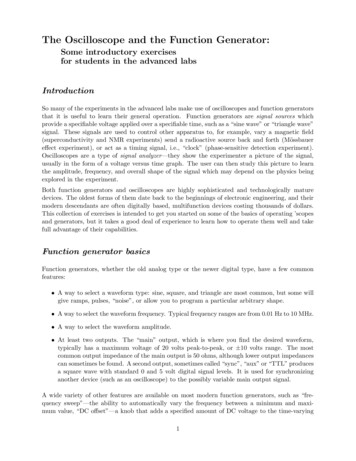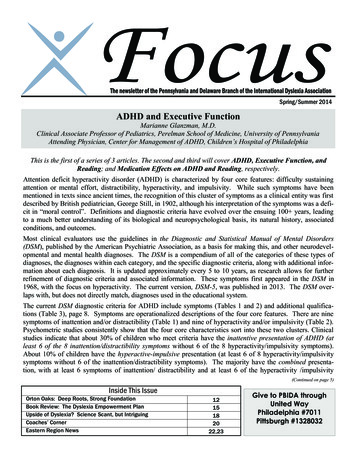
Transcription
Spring/Summer 2014ADHD and Executive FunctionMarianne Glanzman, M.D.Clinical Associate Professor of Pediatrics, Perelman School of Medicine, University of PennsylvaniaAttending Physician, Center for Management of ADHD, Children’s Hospital of PhiladelphiaThis is the first of a series of 3 articles. The second and third will cover ADHD, Executive Function, andReading; and Medication Effects on ADHD and Reading, respectively.Attention deficit hyperactivity disorder (ADHD) is characterized by four core features: difficulty sustainingattention or mental effort, distractibility, hyperactivity, and impulsivity. While such symptoms have beenmentioned in texts since ancient times, the recognition of this cluster of symptoms as a clinical entity was firstdescribed by British pediatrician, George Still, in 1902, although his interpretation of the symptoms was a deficit in “moral control”. Definitions and diagnostic criteria have evolved over the ensuing 100 years, leadingto a much better understanding of its biological and neuropsychological basis, its natural history, associatedconditions, and outcomes.Most clinical evaluators use the guidelines in the Diagnostic and Statistical Manual of Mental Disorders(DSM), published by the American Psychiatric Association, as a basis for making this, and other neurodevelopmental and mental health diagnoses. The DSM is a compendium of all of the categories of these types ofdiagnoses, the diagnoses within each category, and the specific diagnostic criteria, along with additional information about each diagnosis. It is updated approximately every 5 to 10 years, as research allows for furtherrefinement of diagnostic criteria and associated information. These symptoms first appeared in the DSM in1968, with the focus on hyperactivity. The current version, DSM-5, was published in 2013. The DSM overlaps with, but does not directly match, diagnoses used in the educational system.The current DSM diagnostic criteria for ADHD include symptoms (Tables 1 and 2) and additional qualifications (Table 3), page 8. Symptoms are operationalized descriptions of the four core features. There are ninesymptoms of inattention and/or distractibility (Table 1) and nine of hyperactivity and/or impulsivity (Table 2).Psychometric studies consistently show that the four core characteristics sort into these two clusters. Clinicalstudies indicate that about 30% of children who meet criteria have the inattentive presentation of ADHD (atleast 6 of the 8 inattention/distractibility symptoms without 6 of the 8 hyperactivity/impulsivity symptoms).About 10% of children have the hyperactive-impulsive presentation (at least 6 of 8 hyperactivity/impulsivitysymptoms without 6 of the inattention/distractibility symptoms). The majority have the combined presentation, with at least 6 symptoms of inattention/ distractibility and at least 6 of the hyperactivity /impulsivity(Continued on page 5)Inside This IssueOrton Oaks: Deep Roots, Strong FoundationBook Review: The Dyslexia Empowerment PlanUpside of Dyslexia? Science Scant, but IntriguingCoaches’ CornerEastern Region News1215182022,23Give to PBIDA throughUnited WayPhiladelphia #7011Pittsburgh #1328032
Letter from the PresidentIn the last Focus, I wrote about the importance of the IDA’s Standards of Knowledge and Practice for Teachers of Reading. These Standards, when fully realized, will ensure that all teachers who work with elementary-aged children will beexperienced in using evidence-based, multi-sensory methods for teaching reading.Last week I joined a conference call from IDA that continued the conversation about the Standards. IDA sets up suchcalls on a regular basis so Branches can get updates on what is going on at the national level, as well as to be able tovoice any concerns we have about issues at the Branch level.During this latest conference call, Hal Malchow, IDA President-Elect, and Liz Liptak, who is IDA’s Director for Professional Development, presented the goals of IDA for the implementation of the Standards of Knowledge and Practiceinitiative and beyond.First, Hal Malchow commented on the necessity to develop a “brand name” for the reading instruction methodology thatwe promote. This process has already begun with a request asking for suggestions for a name. The second step in thenaming process will be to do a ranking survey among the IDA membership to determine which are the “best” choices forthe name. The third step will be a Google survey to get broad input from the general public to ascertain which namesbring the best response. The goals are for all membership to feel invested in the process of developing a “brand name”for the methodology we espouse, and to engage IDA members and the general public in awareness of the process as wellas the final choice of a name for the instructional methodology.Liz Liptak outlined IDA goals for promoting increased adoption of the Standards. First, beyond reviewing and approving the reading instruction curricula at institutions of higher education, IDA is working toward accrediting programs thatmeet the requirements of the Standards during the review process As you already know, St. Joseph’s University’s Master’s of Special Education, Teacher Scholar Program, in Philadelphia has successfully completed the IDA review process. Several other Pennsylvania institutions are preparing for review.Second, IDA is looking at reviewing and accrediting independent teacher training organizations such as IMSLEC andNILD, both of which have already been accredited.IDA proposes developing an accreditation program for independent schools that teach children with dyslexia and otherspecial learning needs. The accreditation would mean that the school meets the criteria for employing appropriate methodology for the teaching of reading. As this initiative gets underway, IDA will be looking for suggestions for schools tobe reviewed.Fourth, IDA wants to develop a certification process for individuals --“dyslexia specialists” as well as regular classroomteachers -- that could be similar to programs such as ASHA’s Certificate of Clinical Competence. IDA has identified acompany that develops exams for this kind of professional certification. In this effort, IDA will be looking forindividuals who are willing to take the exam as part of its development.Finally, as an organization that seeks to offer this kind of accreditation/certification for institutions and individuals, IDAwill seek to become registered as a “standards developer.” This will require support from groups or individuals whounderstand and make use of the standards, as well as a period when the standards are presented to the general public.Clearly, this is a monumental undertaking, but when complete, will make a huge and positive difference in how all children are taught to read.Julia Sadtler, President, Pennsylvania Branch of the International Dyslexia AssociationAdvertising in FocusFocus is published three times a year by the Pennsylvania Branchof the International Dyslexia Association. We welcome submissions of articles, Calendar of Events, The Heroes of Dyslexia, andadvertising. Please submit to Tracy Bowes at dyslexia@pbida.orgor (610)527-1548.Advertising Rates:Full Page 150Half Page 110Quarter Page 70Back Cover 300Please send payment to: PBIDA, 1062 E. Lancaster Avenue,Suite 15A, Rosemont, PA 19010.IDA DisclaimerThe International Dyslexia Association supportsefforts to provide individuals with dyslexia appropriate instruction and to identify these individuals at an early age. The Association and thePennsylvania Branch, however, do not endorseany specific program, speaker, product, or instructional material, noting that there are a number of such which present the critical componentsof instruction as defined by IDA.2
Letter from the EditorsThis issue of Focus will reach you in the spring of 2014, a spring which we await with more eagerness thanusual. While parents have no doubt enjoyed the occasional sledding, hot chocolate and joy of not rushing inthe mornings, we all acknowledge that multiple days of missed school create havoc for children, their parentsand their teachers. Missing school no doubt has even more impact on children with learning disabilities, asthey benefit from repetition and practice in instruction, strategies which are challenged.So parents deserve a special round of applause this spring. And the current issue of Focus includes several articles which will help parents. Becky Scott (Coaches’ Corner) writes about the power and importance of perseverance; we all know, no matter what our cognitive profiles, that perseverance (or its lack) has been a majorfactor in our lives. Scott offers explicit, practical and non-burdensome suggestions which parents can use tobuild perseverance in their children. Second, Alison Enslein (Parents’ Corner), reviews Ben Foss’s book, TheDyslexia Empowerment Plan; A Blueprint for Renewing Your Child’s Confidence and Love of Learning.This book empowers parents to teach their children to advocate for themselves, to help their children understand their strengths, and to create a community of support. The book is both practical and encouraging. Finally, Carolyn Cowen and Gordon Sherman carefully consider the question of a possible relationship betweendyslexia and ‘talents’; they review the scant research in this area and discuss the importance of cerebrodiversity.We are very proud to include a comprehensive summary of the science and understanding of ADHD and Executive Function by Marianne Glanzman, M.D. Both professionals and parents will benefit from this clear explanation of the ‘state of the art’ in our understanding and use of these diagnoses.In the last issue Focus featured The Hillside School in Macungie, Pennsylvania. Two brief articles about Hillside in this issue describe the school’s approach to technology and their new middle school.In this issue, we introduce a column on Orton Oaks, individuals who have been continuous members ofPBIDA for 25 years. The considerable accomplishments and contributions of two individuals are described;we will profile PBIDA’s other generous ‘Orton Oaks’ in subsequent issues.We encourage you to send us your suggestions for future articles and your comments on the present articles.The purpose of Focus is to provide PBIDA members with useful and exciting information; please help us to doso by letting us know what you think.Marlyn VogelCo-EditorNanie FlahertyCo-EditorPBIDA1062 E. Lancaster Avenue, #15ARosemont, PA 19010Phone: (610) 527-1548Toll-Free phone: (855) 220-8885Fax: (610) 527-5011Email: dyslexia@pbida.orgWeb: www.pbida.orgStay in the loop!"DyslexiaPennsylvaniaDelaware”on n erestinterest.updatesononPBIDAevents3
News from PBIDA’s Pittsburgh RegionNews from PBIDA’s Pittsburgh RegionThe Pittsburgh Regional Committee took time out from preparationThePittsburghCommitteetimeout Afrompreparationfor theirApril onferenceforProfessionals and Parents, to present Experience Dyslexia: A yslexia:ASimulation on March 13. The simulation was sponsored by the Alleghenytion on MarchUnit13. Non-PublicThe simulationwas Program,sponsoredandby thethe nitNon-PublicSchoolsProgram,andthe60participants were teachers and parents from non-public schools. Thoseof .Thoseof uswho presented the simulation were reminded again of how powerfulitwhotheexperiencesimulation difficultywere remindedof howthatpowerfulitis forpresentedpeople edifficultydoingsomethingthatusuallyseems easy. Many participants realized for the first time how hardseemsparticipantsrealizedthe firsttime tohowhardchildreneasy.withManydyslexiaare workingas theyforstruggleto learnread.children with dyslexia are working as they struggle to learn to read.The Pittsburgh Region was proud to present the third biennial PBIDAThePittsburghRegion wasproudpresentthe speakerthird biennialPBIDAconferencein Pittsburgh.Thisyeartoourkeynotewas Dr.Eric Tridas, National IDA President. He presented wasDr.EricDisorders.”Tridas, NationalIDADr.President.He presentedon“The Developmental Web: Diagnosis and Management of LearningAlthoughTridas spokeon a similartopic in Philadelphia in 2012, this was a chance for many other people in the western end of our state to get this infortopicin Philadelphia2012,this towasa chancefor manyother peopleandin thewestern endincludedof our stateto getonthisinformation.Other ratorsincludedsessionsonInattention, Dyslexia, and Anxiety; Teaching Writing to Dyslexic Students; Diagnosis – What Now?; Appropriate SDIs andtion,Dyslexia, andSurvivingAnxiety; TeachingWritingto DyslexicStudents; Reading;DiagnosisAssistive– What Now?;AppropriateSDIs andandAccommodations;your Child’sHomework;MultisensoryTechnology:iPad dMore; and a preview of the Dyslexia Simulation.More; and a preview of the Dyslexia Simulation.In addition to the workshops, participants at the conference got to see up-to-date materials and information from 14In addition to andthe schools.workshops,participantsat thethisconferencegotwithoutto see up-to-dateand informationfromop14organizationsBeingable to accessinformationtraveling tomaterialsPhiladelphiawas an thisinformationwithout
), reviews Ben Foss’s book, The Dyslexia Empowerment Plan; A Blueprint for Renewing Your Child’s Confidence and Love of Learning. This book empowers parents to teach their children to advocate for themselves, to help their children under-stand their strengths, and to create a community of support. The book is both practical and encouraging. Fi-
